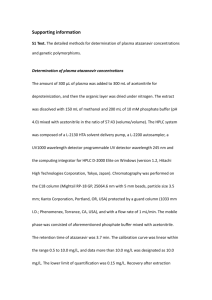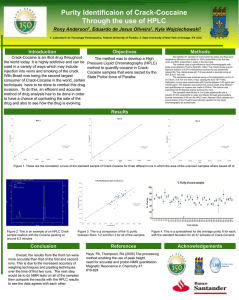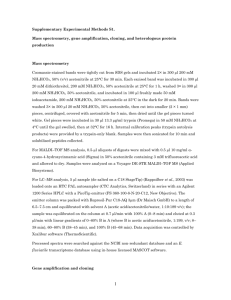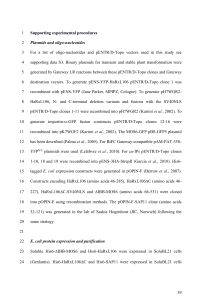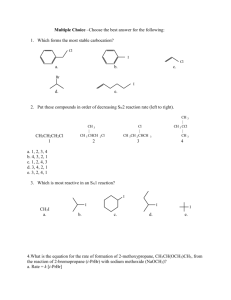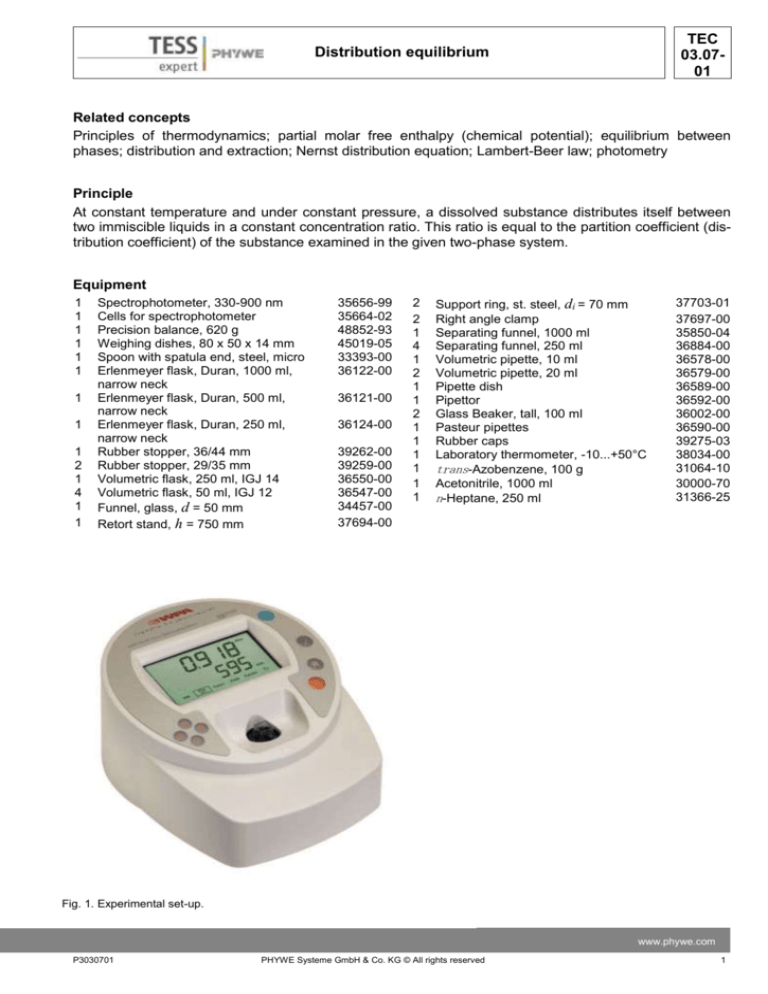
TEC
03.0701
Distribution equilibrium
Related concepts
Principles of thermodynamics; partial molar free enthalpy (chemical potential); equilibrium between
phases; distribution and extraction; Nernst distribution equation; Lambert-Beer law; photometry
Principle
At constant temperature and under constant pressure, a dissolved substance distributes itself between
two immiscible liquids in a constant concentration ratio. This ratio is equal to the partition coefficient (distribution coefficient) of the substance examined in the given two-phase system.
Equipment
1
1
1
1
1
1
1
1
1
2
1
4
1
1
Spectrophotometer, 330-900 nm
Cells for spectrophotometer
Precision balance, 620 g
Weighing dishes, 80 x 50 x 14 mm
Spoon with spatula end, steel, micro
Erlenmeyer flask, Duran, 1000 ml,
narrow neck
Erlenmeyer flask, Duran, 500 ml,
narrow neck
Erlenmeyer flask, Duran, 250 ml,
narrow neck
Rubber stopper, 36/44 mm
Rubber stopper, 29/35 mm
Volumetric flask, 250 ml, IGJ 14
Volumetric flask, 50 ml, IGJ 12
Funnel, glass, d = 50 mm
Retort stand, h = 750 mm
35656-99
35664-02
48852-93
45019-05
33393-00
36122-00
36121-00
36124-00
39262-00
39259-00
36550-00
36547-00
34457-00
37694-00
2
2
1
4
1
2
1
1
2
1
1
1
1
1
1
Support ring, st. steel, di = 70 mm
Right angle clamp
Separating funnel, 1000 ml
Separating funnel, 250 ml
Volumetric pipette, 10 ml
Volumetric pipette, 20 ml
Pipette dish
Pipettor
Glass Beaker, tall, 100 ml
Pasteur pipettes
Rubber caps
Laboratory thermometer, -10...+50°C
trans-Azobenzene, 100 g
Acetonitrile, 1000 ml
n-Heptane, 250 ml
37703-01
37697-00
35850-04
36884-00
36578-00
36579-00
36589-00
36592-00
36002-00
36590-00
39275-03
38034-00
31064-10
30000-70
31366-25
Fig. 1. Experimental set-up.
www.phywe.com
P3030701
PHYWE Systeme GmbH & Co. KG © All rights reserved
1
TEC
03.0701
Distribution equilibrium
Tasks
Measure the extinction of various concentrated solutions of trans-azobenzene in acetonitrile at constant
wavelength. Subsequently determine the equilibrium concentrations (extinctions) of trans-azobenzene in
the system n-heptane/acetonitrile after single and repeated distribution at constant temperature. Calculate the partition coefficients and effectiveness of the extractions from the experimental data and compare them.
Set-up and Procedure
The spectrophotometer that is required for this experiment is shown in Fig. 1.
Acetonitrile saturated with n-heptane, and n-heptane saturated with acetonitrile are required for this experiment. Prepare them as follows: Pour about 500 ml of acetonitrile and 200 ml of n-heptane into a
1000 ml Erlenmeyer flask and shake vigorously (Caution! Equalize pressure!). Allow the flask to stand
for some time, with vigorous shaking now and again. Use a separating funnel to cleanly separate the
saturated acetonitrile so prepared from the saturated n-heptane, and store each of them in separate, appropriately labelled Erlenmeyer flasks.
Directly prior to measurement, weigh 75 mg (4.12 · 10-4 mol) of trans-azobenzene into a 250 ml volumetric flask and dissolve it in heptane-saturated acetonitrile (fill up to the calibration mark). Prepare dilutions
from this 1.65 · 10-3 molar stock solution as follows: Pipette 10, 20, 30 and 40 ml of the solution each into
a separate 50 ml volumetric flask, then fill each of these four flasks up to the 50 ml mark with heptanesaturated acetonitrile.
Measure and record the extinctions of the stock solution and the dilution series at 400 nm, 420 nm and
440 nm, using heptanesaturated acetonitrile as reference in each case. Plot a graph of the measured
values (see Fig. 2).
Carry out the subsequent examinations of the distribution of trans-azobenzene in the prescribed nheptane/acetonitrile two phase system as follows:
a) Single distribution
Pipette exactly 60 ml of the 1.65 · 10-3 molar stock solution of trans-azobenzene in acetonitrile into a
clean, dry separating funnel and cover it with 60 ml of acetonitrile-saturated n-heptane. Shake vigorously
for about 10 minutes (Caution! Equalize pressure!). When the phases have separated, run off the lower
phase and measure the extinction of it at the same wavelengths as previously (400 nm, 420 nm and 440
nm) against heptane-saturated acetonitrile. The upper phase is not required, discard it by pouring it into
the container for organic solvent waste disposal.
b) Repeated distribution
Pipette exactly 60 ml of the stock solution into a clean and dry separating funnel and add to it 20 ml of
acetonitrile-saturated n-heptane. Shake as described above (Caution! Equalize pressure!). When the
phases have separated, run the lower phase quantitatively off into a second clean, dry separating funnel.
Again cover it with 20 ml of acetonitrile-saturated n-heptane and extract as above. Discard the upper
hexane phase as required by waste disposal regulations. Repeat this last extraction in a further separating funnel with a fresh 20 ml of acetonitrile-saturated n-heptane. In this way, a total of 60 ml has again
been used for extraction. Separate off the lower phase and measure the extinction of it at the same
wavelengths as previously with single distribution (400 nm, 420 nm and 440 nm) against heptane- saturated acetonitrile.
The spectra of trans-azobenzene in acetonitrile before and after single and repeated distribution can be
additionally recorded. To do this, measure the extinction of each of the three solutions against heptane-
2
PHYWE Systeme GmbH & Co. KG © All rights reserved
P3030701
Distribution equilibrium
TEC
03.0701
saturated acetonitrile in the range from 360 to 550 nm and steps of 5 nm, and plot the measured values
as shown in Fig. 3. This is not absolutely necessary for the measurement and evaluation, however.
Note: Fresh solutions of trans-azobenzene are to be used, and work with them is to be carried out briskly, as it is not very stable in organic solvents (this is shown by changes in the spectroscopic behaviour,
within as little as a few hours the spectra are no longer reproducible!).
Theory and evaluation
When a solvent 1, in which a substance A is dissolved, is brought into contact with a liquid 2, that is immiscible with solvent 1, then because of:
where
aA,1, aA,2
R
T
Activities of the substance A dissolved in solvent 1 or 2
Universal gas constant
Temperature
a spontaneous transfer of substance into the unoccupied phase 2 takes place up to equalization of the
difference in potentials. The following is valid in the resulting distribution equilibrium:
from which:
and so:
www.phywe.com
P3030701
PHYWE Systeme GmbH & Co. KG © All rights reserved
3
TEC
03.0701
Distribution equilibrium
follows. According to the Nernst distribution law that is expressed in equation (3), the ratio of the activities aA (or concentrations cA on strong dilution) of a substance A that is distributed between two coexisting phases at a given pressure p and a given temperature T is constant and equal to the Nernst partition coefficient kN (distribution constant). This is in the ideal case (no intermolecular effects, substance
A is present in the same form in the two phases) independent of the amount of distributed substance. It
is determined by the nature of the substance A, the type of two-phase system and the temperature. The
temperature dependence can be neglected in practice because of the low distribution enthalpies, so that
work can be carried out at room temperature without the need for thermostatting. It is clear that normally
the phase positioned in the numerator in definition (3) is the liquid of lowest density (upper phase).
To calculate the partition coefficient acc. to (3), the equilibrium concentrations of substance A in the two
phases must be known. Because of (3.1), however, measurements on one phase (the experimentally
most easily handled one) are sufficient.
where:
n(0) A,1, nA,1
V = V2/V1
Initial quantity (n(0)) or equilibrium quantity (n) of A in phase 1. The constant
volume of the lower phase allows conversion to the initial concentration c(0)
A,1 or the equilibrium concentration cA,1 to be made.
Volume ratio of the two phases
Rearranging relationship (3.1) for cA,1, we obtain:
The value of this is, in contrast to the partition coefficient, dependent on the experimental procedure.
When, alternatively to single distribution, pure upper phase is not added as a total volume, but in several
portions for repeated distribution, then analogously to (3.2) we have c(1) A,1 for the equilibrium concentration after the first distribution, or extraction, step:
The concentration remaining in the lower phase after the second distribution step is given when, in
4
PHYWE Systeme GmbH & Co. KG © All rights reserved
P3030701
Distribution equilibrium
TEC
03.0701
(3.2.1), c(0) A,1 is replaced by c(1) A,1 and c(1) A,1 by c(2) A,1:
Correspondingly, after n distribution steps:
Fig. 2: The relationship between extinction
E and concentration c
A
for trans-azobenzene in acetonitrile at λ = 400 nm ( ∆), λ =
420 nm ( O ) and λ = 440 nm ( □ ) (proof of the validity of the Lambert-Beer law).
According to this relationship, the concentration of the substance A remaining in the lower phase falls
with the number of distribution steps, which allows consequences to be drawn for the practical procedure. The quotient of the equilibrium concentration and initial concentration is so a measure of the quality
of the extraction and is named the effectiveness of extraction φ.
www.phywe.com
P3030701
PHYWE Systeme GmbH & Co. KG © All rights reserved
5
TEC
03.0701
Distribution equilibrium
The determination of the concentration of coloured or UV active compounds can be carried out photometrically on the basis of the Lambert-Beer law:
Where
Eλ
eA
cA
d
Extinction at a wavelength of λ
Decadic molar extinction coefficient of substance A at a wavelength of λ
Concentration of substance A in mol/l
Layer thickness in the cell
The validity of this must be experimentally substantiated for the system to be examined (Fig. 2). The extinction values measured before and after distribution can be assigned concentration values from the calibration curves obtained at various wavelengths (Fig. 2) or the corresponding mathematical connections.
Alternatively, when there is a proven linear relationship between E and cA, the extinction values measured for the lower phase before (E0) and after single (E1) or repeated (En) distribution can be used directly in equations (3.1). (3.2.3) and (4) in place of the concentrations, whereby the following changes in the
kN or φ explicit connections can also be made:
6
PHYWE Systeme GmbH & Co. KG © All rights reserved
P3030701
Distribution equilibrium
TEC
03.0701
Data and Results
Fig. 3 shows the ranges of the VIS spectra of trans-azobenzene in acetonitrile recorded before and after
single and repeated distribution at T = 299 K.
The extinctions of the marked absorption bands at λ = 400 nm can be read off from these spectra: E0 =
0.385 (before distribution), E1 = 0.236 (after single distribution) and E3 = 0.216 (after repeated distribution). Together with relationship (6) or (7), a partition coefficient of kN = 0.631 is obtained for E1 with V = 1
and n = 1 (single distribution) and, with relationship (7), an approximately equal value of kN = 0.637 for E3
with V = 1/3 and n = 3 (repeated distribution).
kN = 0.647 was the average value obtained from several calculations at various wavelengths in the proximity of maximum absorption.
As a comparison, the concentration ratios calculated for E3 and E1 using equation (8) give φ3 = 0.570 (for
repeated distribution) compared to φ1 = 0,620 (for single distribution), which do not indicate a substantially greater reduction in trans-azobenzene in the lower phase by repeated distribution with the same total
volume of extraction solvent (n-heptane).
For preparative extraction purposes, therefore, the two-phase system used here should be replaced by a
system with a higher partition coefficient, and so greater extraction effectiveness.
Fig. 3: Segment of the VIS spectrum of trans-azobenzene in acetonitrile before (O) and after single (X) and repeated ( ▽ ) extraction with the same total volume of n-heptane at T = 299 K
Note
The graphical evaluation of the measured values can be very easily carried out by means of ‘Measure’
software. A downloadfile of this software is available as freeware for use in evaluating and graphically
representing measured values under URL “www.phywe.com“. Figs. 2 and 3 were created by this
software.
www.phywe.com
P3030701
PHYWE Systeme GmbH & Co. KG © All rights reserved
7


